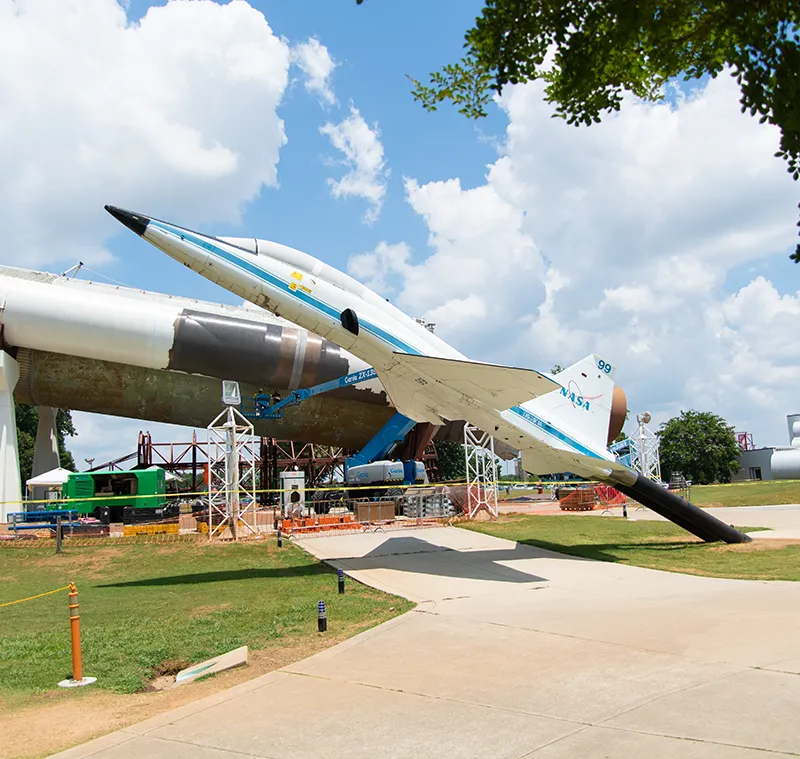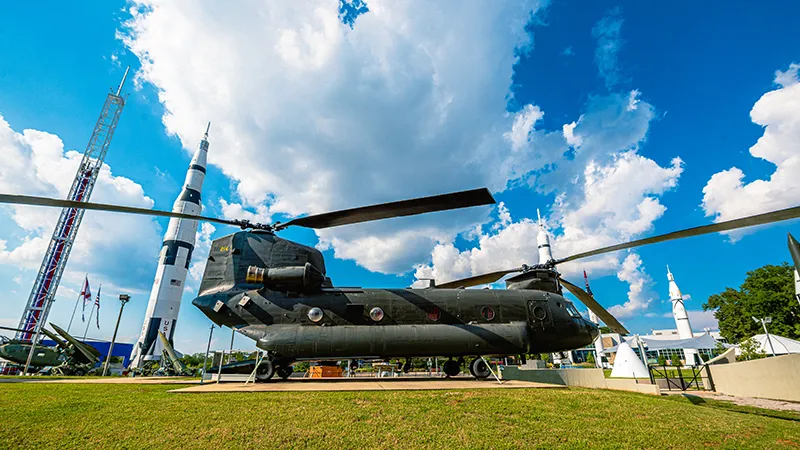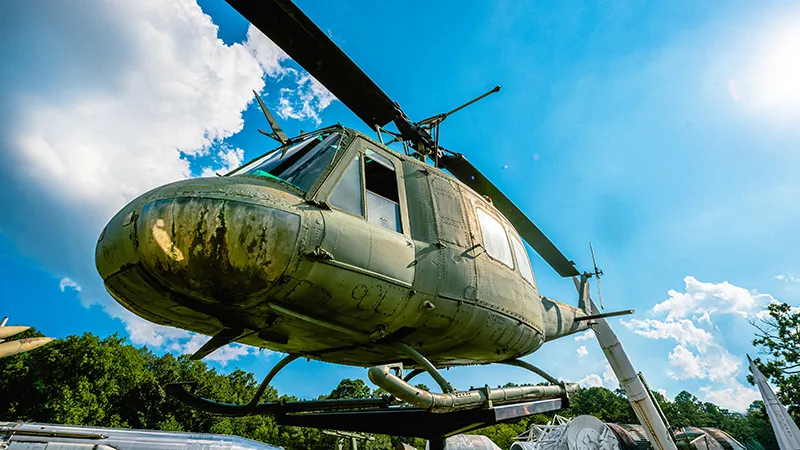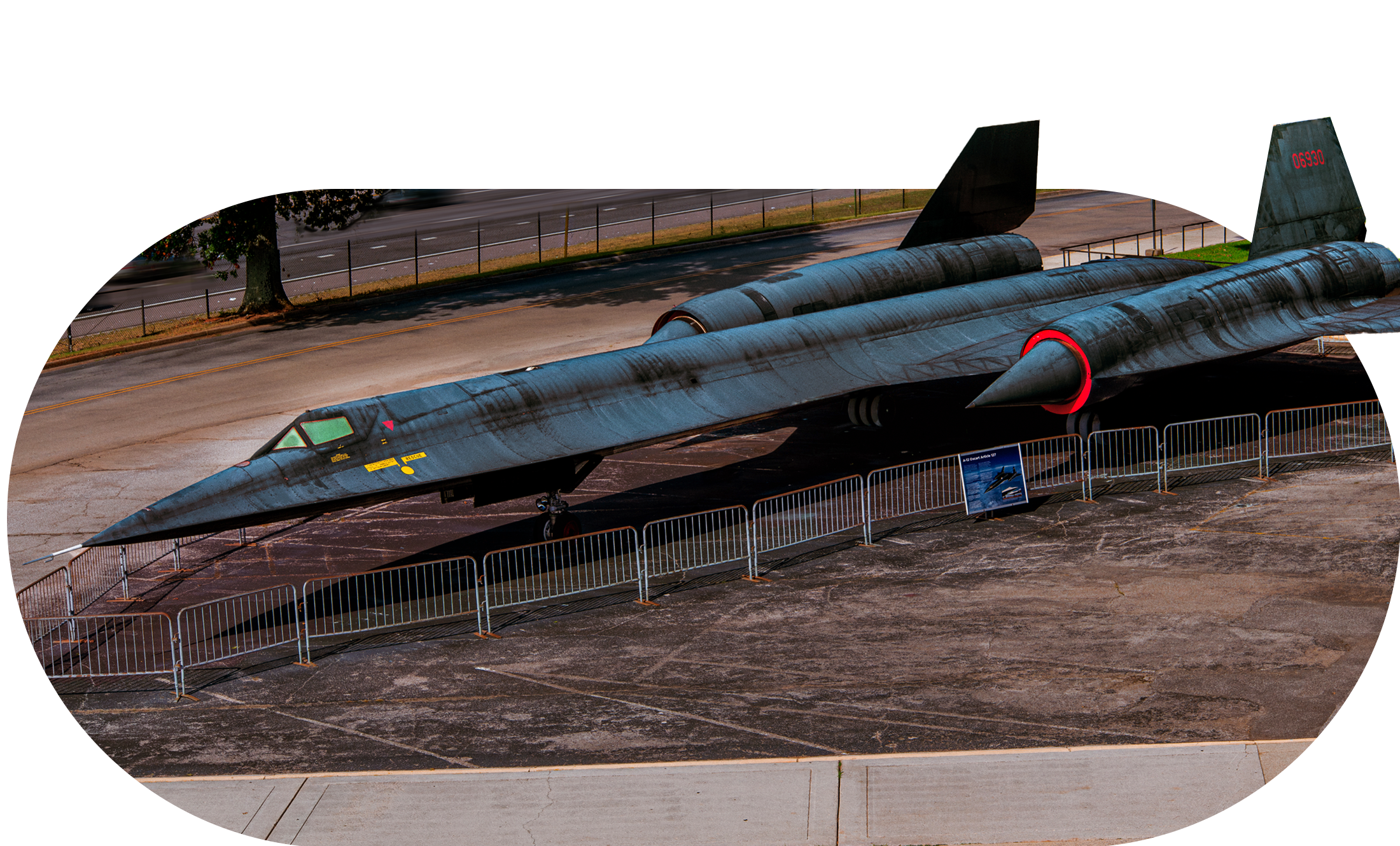Adopt an Artifact
Artifacts at the U.S. Space & Rocket Center play a vital role in our mission as they tell a story through science, engineering, mathematics, and technology feats of past generations. These national treasures not only teach the public about our past, but also play a large role in the education mission of our space, aviation, robotic and cyber camps.
The Adopt an Artifact Program is your opportunity to adopt a piece of history and help us as we honor our past by preserving our historical artifacts of the past and ignite the space stories of the future. Your donation will assist us in our mission of preserving, conserving, and restoring these treasures for future generations so they can better understand the history of space exploration that landed America on the moon.
Adoption Levels
$25 Adoption Kit
- A personalized adoption certificate (PDF download only)
- A photograph and history card of your adopted artifact (PDF download only)
Kits will be emailed for download.
$75 Adoption Kit
- A personalized adoption certificate (8.5×11)
- A photograph and history card of your adopted artifact
- 3-month trial to the Space Camp Explorers Club
Kits will be mailed 2 to 3 weeks after purchase.
Adopt$150 Adoption Kit
- A personalized adoption certificate (8.5×11)
- A photograph and history card of your adopted artifact
- 6-month trial to the Space Camp Explorers Club
- Your name listed for two years on the Foundation’s Adopt an Artifact page
- An entry to win two tickets to the Space Camp Hall of Fame dinner
Kits will be mailed 2 to 3 weeks after purchase.
$300 Adoption Kit
- A personalized adoption certificate (8.5×11)
- A photograph and history card of your adopted artifact
- 6-month trial to the Space Camp Explorers Club
- Your name listed for two years on the Foundation’s Adopt an Artifact page
- An entry to win two tickets to the Space Camp Hall of Fame dinner
- An entry to win artifact and space themed goodies around the holiday
Kits will be mailed 2 to 3 weeks after purchase.
$500 Adoption Kit
- A personalized adoption certificate (8.5×11)
- A photograph and history card of your adopted artifact
- 8-month trial to the Space Camp Explorers Club
- Your name listed for three years on the Foundation’s Adopt an Artifact page
- An entry to win two tickets to the Space Camp Hall of Fame dinner
- An entry to win artifact and space themed goodies around the holiday
- Virtual meet and greet with a docent about your artifact
- Virtual meeting from the Executive Director of the Foundation, Chair of Foundation Board,
and CEO of the Rocket Center providing annual update for the Center
Kits will be mailed 2 to 3 weeks after purchase.
$1,250 Adoption Kit
- A personalized adoption certificate (8.5×11)
- A photograph and history card of your adopted artifact
- 10-month trial to the Space Camp Explorers Club
- Your name listed for four years on the Foundation’s Adopt an Artifact page
- An entry to win two tickets to the Space Camp Hall of Fame dinner
- An entry to win artifact and space themed goodies around the holiday
- Virtual meet and greet with a docent about your artifact
- Virtual meeting from the Executive Director of the Foundation, Chair of Foundation Board,
and CEO of the Rocket Center providing annual update for the Center - Behind the scenes tour for you and 4 guests
- Invite to an additional private event
Kits will be mailed 2 to 3 weeks after purchase.

T-38 Talon
NASA astronauts have trained for the stresses of spaceflight in the high-altitude, two-seater, supersonic T-38 Talon since the 1960s. Developed by Northrop Grumman, the T-38 became the world’s first supersonic jet trainer in 1961 when it entered service for the U.S. Air Force. The jet’s aerobatic capabilities made it ideal for Air Force pilots to train to fly fighters and for NASA astronauts to hone their piloting skills and get accustomed to the g-forces of liftoff and reentry. Nicknamed the “white rocket,” the T-38 requires only 2,300 feet (695.2 meters) of runway. The T-38 on display was delivered to NASA in 1965 and flew in support of the Gemini and Apollo Programs.

Named for Redstone Arsenal where it was developed, the Army Redstone missile played a crucial role in the U. S.’s defense capability. It was nicknamed “Old Reliable” due to its outstanding launch record. First deployed in 1958, the Redstone was the forerunner of the Jupiter missile. The Redstone on display at the U.S. Space & Rocket Center is the first production Redstone manufactured in Warren, Michigan. Its Serial Number CC-001. It was used for training soldiers at Redstone Arsenal, with stamps on interior components that read “For Training Use Only.”

The Juno II was modified from the Jupiter intermediate-range ballistic missile, with upper stages and payload sections added. Juno IIs were used for ten uncrewed launches from 1958-1961. These missions included Pioneer IV, America’s first successful lunar flyby mission and Explorer XI, the first gamma ray detection satellite.
Thank you to these $150-plus Adopt an Artifact donors.
Bianca Steffen

The Saturn I was the first American launch vehicle developed solely for space exploration. It had a 100% success rate, unprecedented for its time. The Saturn I had two versions, Block I and Block II. In the Block II configuration, the Saturn I had stabilizing fins, lengthened fuel tanks and improved H-1 engines. This combination increased the first stage thrust to over 1,500,000 pounds at launch. Since additional performance improvements were necessary to facilitate NASA objectives for the Apollo program, the Saturn I was eventually replaced by the more powerful Saturn IB.
Thank you to these $150-plus Adopt an Artifact donors.
In honor of John W. Tobias
Gregory Manning

The Mercury Redstone is based on the Army Redstone missile. It has an upgraded engine and additional propellant capacity to carry the Mercury space capsule. It was used to launch the first American into space, Alan Shepard, in May 1961. This Mercury-Redstone was used for MR-1, the first test flight. An issue with power and control cables caused the engine to shut down immediately after ignition. MR-1 rose 3.8 inches (9.7 centimeters) before settling back into place. After the test, MR-1 was transported to Marshall Space Flight Center for study before eventual display at the U.S. Space & Rocket Center.
Thank you to these $150-plus Adopt an Artifact donors.
Gretchen Green
In memory of J.C. Hand
Brandon Brooks
Matthew Mifsud
In memory of Dr. Alton R. Prihoda
Eric Herbst Jr.
In memory of Miguel “Micky” Hernandez
Christopher Street

The Juno I is a variant of the Jupiter-C that looked identical but added an additional single-motor upper stage and was specifically designed to carry lightweight payloads into low-Earth orbit. A Juno I launch vehicle was used to launch America’s first satellite, Explorer I, on January 31, 1958.

The Jupiter was America’s first intermediate-range ballistic missile and was used to launch two monkeys into space on May 28, 1959. Achieving an altitude of 300 miles (480 meters), monkeynauts Able and Baker were the first primates to be launched into space and successfully recovered. Miss Baker spent the later years of her life at the U.S. Space & Rocket Center.
Thank you to these $150-plus Adopt an Artifact donors.

The Saturn V is a symbol of ingenuity and “can-do” spirit for the world. The iconic Saturn V replica that stands on the grounds of the U.S. Space & Rocket Center in Huntsville, AL, inspires hundreds of thousands who visit the Center each year from all over the United States and around the world. Built in 1999, the Saturn V replica sends a reminder that achieving lofty dreams is possible. Your help enables the preventive maintenance that protects this landmark from the effects of weathering.
Thank you to these $150-plus Adopt an Artifact donors.
Justin Prosser
Peter Von Braun
Scott Allendorf
In Honor of Henry Andrews
In Honor of Alexander Boudreaux
In Honor of Judah Browder
In Honor of Jonathan Camp
Alyssa Carson
Moses Chen
In Honor of Joseph Corso
In Honor of Aashan and Saahan Dahagam
In Honor of Sebastian Saracwni
Edward Del Grosso
In Honor of Luke and Ben Watterson
Jameson Dooley
In Honor of Kollyn Dyer
In Honor of Ronald Adams
In Honor of Andrew Fournier
Brian and Angela Garls
In Memory of Owen Garriott
In Honor of Greyson Hammond
In Honor of Jasper and Shepherd Scott
Innova Primary Care
Timothy Johnson
The Kitson Family: Kiersten, Raymond, Kyler, Lucas & Mary
In Memory of Paul Hundley
In Memory of Kathryn Lyons
In Honor of James Boyd Moore Jr.
In Honor of Durward Mosley
In Honor of Jack Stokes
In Honor of William Oligmueller
In Honor of Philip Reaves
Ari Porter
George Shry
Jason Sims
Bianca Steffen
Ashlee Stevenson
Agrin Health
In Honor of Clinton Thomason
In Honor of Trace Tillman
Christopher VanHuysse
In Memory of Toto Vish
In Memory of Jack LaFollette
Frank Bondietti Jr.
Robert Daily
Leona Hammond
Kevin Smith
Tim Drake
Everett Stowe
Scott Henderson
William Peterson
Nicholas Peterson
Aashan and Saahan Dahagam
Lindsay Lackey
Denise Hendrix
Britt and Teri Johnson
In Memory of John B.E. Chase
Drew Baxter

A-12 Oxcart was the successor to the U2 Spy plane and developed by the CIA. The Oxcart became operational in 1965. Single seat aircraft unlike the SR-71. In creating the Oxcart new cutting edge innovations took place in titanium fabrication along with new jet fuels and flight controls, electronic counter measures, along with the pilot life support system. Speed Mach 3.2 or just over 2200 miles per hour at 90,000 ft. Camera system on the A-12 was better than the 71 but the 71 could collect more data giving the 71 an advantage.
Thank you to these $150-plus Adopt an Artifact donors.
The Stout Family
In Honor of Elizabeth Garrett
In Honor of Myles Leazott
Warren Mason
Joshua Pietrzyk
Gautam Shah
Lee Smith
Kevin Flahaut
Rob Daily
Andrew Salas
Claire Douthit

This aircraft, an F-14A, Bureau Number 160661, was a part of Navy Fighter Squadron VF-51, aboard the USS Carl Vinson (CVN-70) on its maiden voyage and in VF-124 at Naval Air Station Miramar, CA, where it served as a training aircraft. This aircraft also participated in a NASA effort to improve F-14 maneuvering. The F-14 Tomcat was a supersonic, twin-engine, variable sweep wing, two-seat fighter designed for the US Navy. The F-14’s AWG-9 radar was a powerful Pulse-Doppler, multi-mode system that tracked up to 24 targets simultaneously, attacked six targets with its Phoenix AIM-54A missiles closed-circuit while continuing to scan the airspace.
Thank you to these $150-plus Adopt an Artifact donors.
In Honor of Joseph Corso
In Memory of Gerald Powers
Taylor Ford
William “Hotdog” and Tosha Hudson
Wes Kelley
Brian Kirkland
In Honor of Joint Task Force 15
In Honor of James May
In Honor of Mark Zinck
In Honor of Makayla Shane
Daniel Thompson
Kaeden Vallejo
In Honor of Lucas Young
Robert McDermott
S.D.B. Consultants, LTD
Zachary Colescott
Cassandra Reid
Mason Nall
Emily Costigan
John “Goose” Guzior
Christopher Malone
George Adornato
Gretchen Green
Andrew Salas
Holton Jackson

The Pathfinder was constructed at the Marshall Space Flight Center in 1977 as an Orbiter Simulator. It was designed to be a stand-in for the Orbiter Enterprise, which was to be involved in extensive ground testing at the center. In early 1978, the Pathfinder was hoisted to the top of Marshall’s 4OO-foot tall Dynamics Test Stand in “dry runs” for the Mated Vertical Ground Vibration Tests planned for Enterprise. It was destined to become part of the world’s only launch configuration (full stack) shuttle display. In May of 1988 Pathfinder was placed on top of the External Tank in Shuttle Park.
Thank you to these $150-plus Adopt an Artifact donors.
John Cannon
Michael Cosner
In Honor of Olivia Saraceni
In Honor of Tyler Dobson
In Honor of Renee and Lauren Driver
In Honor of the Eckard Family
Kevin Ficek
Veronica Foreman
In Memory of Crew of Columbia’s STS 107
Kyle and Kim Freundl
James Gamble
In Honor of Olivia Hammond
Brian Kirkland
In Honor of Jack Ellis
David McKinley
Scott Mickle
Jimmy Powell
In Honor of Grace Roberts
Tim Rosener
Peter Ryan
Patricia Sallin
Keith Schonrock III
Robert Shaw
In Memory of Quentin Soprano
In Memory of Joshua Stokes
In Honor of Bruce Thomas
In Honor of Sarah Grace Walder
C & M Property Holdings LLC
Solar Eclipse Timer
Kevin Flahaut
Jacqueline Brody
Brian Dicken
Christopher Lane
Jonathan Hinds
Moses Chen
Charles Woodward
Sharon Timmons
Jennifer Clouse
Frederick Lawrence
John Freeze
Gretchen Green
In Memory of David A. Belcher
Carole Graham
Christina Hansen
In Honor of Space Camp Counselors Everywhere!
Doug Hibbard

Thank you to these $150-plus Adopt an Artifact donors.
Nokomis Deckard
Olivia Saraceni
Elaine Ciaccio
Scott Harbour
Gretchen Green
Jeremy Hooper
Matthew Koebbe

This MQF housed the Apollo 12 astronauts. NASA hired Melpar, Inc. to build four MQFs for Apollo missions 11-14. The MQF was fabricated with an Airstream shell built on a customized platform, complete with living space and a medical diagnostic center. The MQF program was developed in reaction to fears about human exposure to possible Moon organisms unknown on Earth that could initiate an uncontrollable epidemic. This modified Airstream trailer was used by returning Apollo 12 astronauts Alan L. Bean, Richard Gordon, and Charles “Pete” Conrad. The crew stayed in the MQF while it was flown from the recovery aircraft carrier Hornet to the Johnson Space Center in Houston, and then for several more days while at the center for a total confinement of approximately 65 hours. In 2007, the U.S. Space & Rocket Center (USSRC) received an email from Dr. Paul Johnson, a supervisor for the Alabama Department of Conservation. Johnson had discovered an old Airstream trailer at a fish hatchery in Marion, Alabama. Being a space enthusiast, he suspected this was no ordinary Airstream. The USSRC confirmed it was the Apollo 12 MQF.
Thank you to these $150-plus Adopt an Artifact donors.
Alexandra Barnes-Schwartz
Rebecca Uhlmann
Nikki Larson
Joseph Thomas Rauch
John M Halpin

Thank you to these $150-plus Adopt an Artifact donors.
Owen Garriott
Lynn Strunk
Billy Bass
Harold Zapolsky and Robert Williams
Melinda Dellert
Walter T. Johnson
Jackson Levine
Rob Daily
Louis Wasson

CH-47D Chinook
The workhorse of the U.S. Army, the Boeing Chinook is a tandem-rotor, heavy-lift transport helicopter designed t o move personnel, supplies, and equipment in support of combat operations. Secondary missions include medical evacuation, disaster relief, firefighting, and search and rescue. The tandem rotors—one in front of the other—provide superb handling capabilities, enabling the Chinook to operate in difficult environmental conditions that can prevent other helicopters from flying. The Chinook was named after the Native American Chinook people.
Thank you to these $150-plus Adopt an Artifact donors.

UH-1B Iroquois “Huey”
The Bell UH-1 Iroquois, better known as the “Huey,” became the most widely used military helicopter during the Vietnam War. It first arrived in Vietnam in 1963 and quickly proved its versatility. The Huey carried out many types of missions, including moving troops quickly to front-line positions. By the end of the war, more than 5,000 Hueys had been sent to Southeast Asia. Hueys were used for medical evacuations, command and control, air assaults, and transporting people and supplies. This aircraft, a UH-1H, was the most produced model in the Iroquois family.
Frequently Asked Questions
-
What does it mean to preserve, conserve or restore artifacts?
Taking actions that anticipate or prevent deterioration, maintaining an item in its original condition, or returning the deteriorated item to its original or near-original condition.
-
Will my donation go to conserve a specific artifact?
Yes. You will have the option to choose which artifact you would like to adopt in the drop-down menu.
-
Can I view any of the artifacts?
Yes. Several are currently on display in our permanent exhibition areas. However, some artifacts are currently offline or in a work/storage area. To check the online status of an artifact, please email [email protected].
-
Will I get a letter for tax purposes?
You will immediately receive an email confirmation and our team will send a tax receipt/confirmation letter within two weeks of receipt of your donation.
-
Can I adopt in someone else’s name?
Yes. An artifact can be adopted in honor of or in memory of someone, or you can surprise someone with an adoption gift!

Have questions about Adopt an Artifact?
Reach out if you have a question or suggestion about the Adopt an Artifact program.
